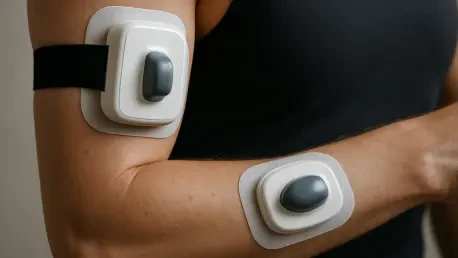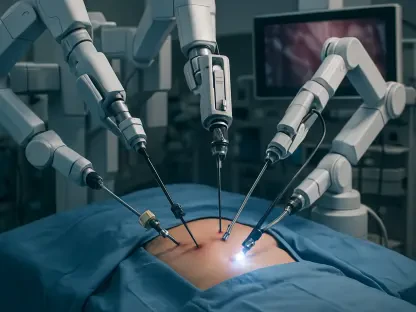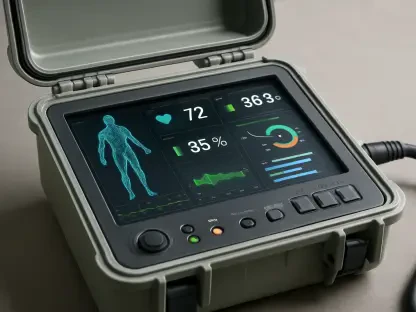Picture a world where a small, adaptable device clings comfortably to the skin, monitors vital health metrics with astonishing precision, and simultaneously treats chronic ailments like arthritis without the need for invasive procedures or hospital visits. This vision is no longer a distant dream but a tangible reality being shaped by pioneering researchers at the Korea Advanced Institute of Science and Technology (KAIST). Under the guidance of Professor Hyunjoo Jenny Lee, a team has unveiled a remarkable wearable ultrasound sensor that promises to redefine the boundaries of medical diagnostics and therapy. This innovation, blending flexibility with high performance, tackles long-standing challenges in ultrasound technology, offering a glimpse into a future where healthcare becomes more personalized and accessible. As this technology evolves, it raises compelling questions about how such devices could integrate into everyday life, potentially transforming patient care on a global scale.
Overcoming Limitations in Ultrasound Design
The journey to this breakthrough begins with recognizing the persistent flaws in traditional wearable ultrasound sensors, which have struggled to deliver on their potential due to inadequate acoustic power, unstable structures, and an inability to conform to the body’s natural contours. These issues have historically limited their use in delivering clear imaging or effective therapeutic outcomes, often leaving patients and clinicians reliant on bulkier, less adaptable equipment. The KAIST team’s solution, detailed in a recent publication in npj Flexible Electronics, introduces a novel “flex-to-rigid (FTR)” capacitive micromachined ultrasonic transducer (CMUT). This design marks a significant departure from past constraints by offering a device that adapts to individual needs while maintaining the strength required for medical applications, setting a new standard for what wearable tech can achieve in healthcare settings.
A closer look at this innovative sensor reveals a sophisticated mechanism driven by a low-melting-point alloy (LMPA), which enables the device to transition seamlessly between flexible and rigid states. When an electric current is applied, the alloy melts, allowing the sensor to mold to the body’s shape; once the current is removed, it solidifies, securing the curvature for optimal performance. This adaptability is enhanced by a hybrid structure combining a rigid silicon substrate with a flexible elastomer bridge, ensuring both mechanical versatility and powerful acoustic output. Unlike older models that often produced blurred focal points due to insufficient elastic modulus, this design achieves precise targeting without the need for complex beamforming electronics. Such advancements highlight a pivotal shift in how ultrasound technology can be integrated into wearable formats, promising greater accuracy and ease of use for a range of medical purposes.
Unlocking New Therapeutic Horizons
One of the most exciting aspects of this wearable ultrasound sensor lies in its capacity to go beyond mere diagnostics and offer noninvasive therapeutic solutions. The device supports low-intensity focused ultrasound (LIFU), a technique that gently stimulates tissues without causing harm, opening up possibilities for treating conditions in a way that minimizes patient discomfort. Animal studies conducted by the KAIST team have demonstrated impressive results, particularly in reducing inflammation and improving mobility in arthritis models through targeted spleen stimulation. These findings suggest a future where chronic conditions could be managed effectively outside clinical environments, reducing reliance on invasive surgeries or prolonged medication regimens, and offering patients a less disruptive path to recovery and improved quality of life.
Equally significant is the alignment of this technology with the growing demand for personalized and minimally invasive healthcare solutions. The sensor’s body-conforming design ensures it can cater to individual anatomical differences, providing tailored care that feels intuitive rather than one-size-fits-all. Additionally, its compatibility with semiconductor manufacturing processes hints at the potential for large-scale production, which could make such advanced tools as commonplace as wearable fitness trackers. Envisioning a scenario where these devices are integrated into home-use or portable medical systems underscores their transformative potential. By bridging the gap between cutting-edge innovation and everyday accessibility, this technology could democratize advanced care, ensuring that more people benefit from sophisticated treatments without the barriers of cost or location.
Envisioning a Smarter Medical Landscape
Looking ahead, the ambitions of the KAIST research team extend far beyond the current capabilities of their wearable ultrasound sensor, with plans to develop a two-dimensional (2D) array configuration that could enable simultaneous high-resolution imaging and therapy. Such an advancement would position the device as a cornerstone of smart medical systems, merging diagnostic precision with treatment delivery in a single, seamless package. This forward-thinking approach reflects the broader industry trend toward creating multifunctional tools that adapt to complex healthcare needs. As these sensors evolve, they could play a central role in redefining patient care, offering solutions that are not only reactive to health issues but also proactive in preventing them through continuous monitoring and timely intervention.
Reflecting on the strides made, it’s evident that the groundwork laid by this research has carved a path for significant improvements in how medical technology interfaces with human needs. The successful development of an FTR design paired with LMPA integration has addressed critical shortcomings of past ultrasound sensors, delivering both performance and adaptability. The demonstrated therapeutic benefits in preclinical trials underscore the practical value of noninvasive treatments. With compatibility for mass production already in sight, alongside future plans for enhanced 2D arrays, the efforts of the past have built a foundation for scalable, impactful solutions. These steps forward invite consideration of how to integrate such innovations into broader healthcare frameworks, ensuring that the benefits of advanced ultrasound technology reach diverse populations while continuing to push the boundaries of what smart medical devices can accomplish.









